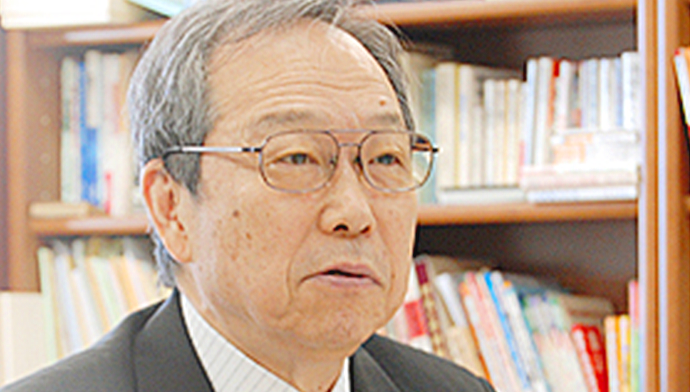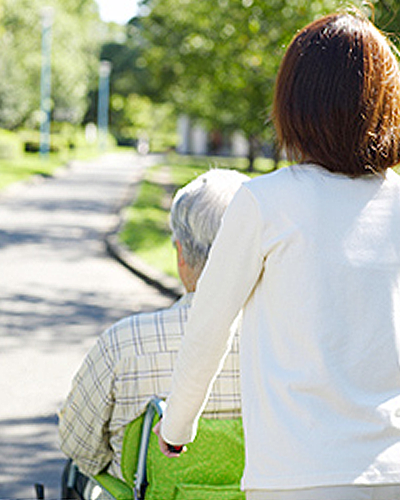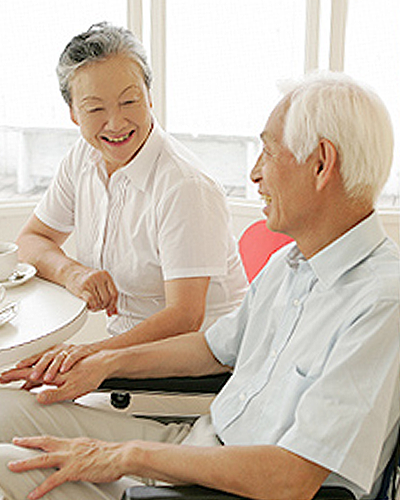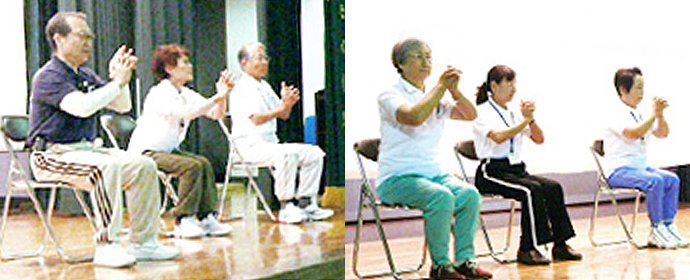Dr. Hitoshi Ota (MD)
 Caregiving/recovery for those who can sit up and stand
Caregiving/recovery for those who can sit up and stand
Dr. Hitoshi Ota is a leader in medical rehabilitation and nursing care. We asked him to give us some hints on in-home nursing care and the best way to approach recovery and rehabilitation, as well as tell us about the Silver Rehabilitation Exercises he designed.
What should caregivers keep in mind with in-home nursing care and recovery?
First of all, the caregiver must firmly resolve to provide care (either alone or with family members). That is more important than anything else.
Whether or not they are able to make that commitment upfront completely changes the daily and emotional experience of caregiving, which in turn drives the way the caregiver acts.
Once a firm resolution is made, it’s time for the caregiver to start educating themselves.
Although there is so much information available about caregiving, new caregivers never imagined it would be relevant to them. So the first thing to realize is that you actually know nothing about caregiving at all. But that’s completely natural. And it’s the perfect place to start.
All you have to do is go to the hospital where the person was admitted or to a local government agency, and start from square one. You can get all the necessary information like care systems and care managers there.

What are the requirements for in-home nursing care?
I use the term 1S5M to define the requirements for in-home caregiving.
The S stands for “space”, and the five M’s are “manpower”, “machines”, “money”, “management”, and “mindset”.
We’ll start with space. If your hallways and bathrooms aren’t big enough for a wheelchair to get through, for example, it’s going to be very difficult for you to provide in-home care. Caregivers also need their rest periodically, so ideally there will be three caregivers attending to the person over the course of two days (this includes helpers and day care providers outside the family). That’s the manpower part.
Obviously machines or devices are needed—things like beds and wheelchairs—and you’ll need money if you’re going to take advantage of outside services and equipment.
Management is critical for making sure everyone in the family knows exactly what’s expected and for effectively coordinating any outside services as well. Mindset has to do with the resolve and commitment I mentioned at the outset. That part is critical.
The 1S5M tool lets in-home caregivers assess whether they are satisfying all the requirements and whether anything is missing and think about whether/how they can incorporate it (external management, for example, could be entrusted to a professional care manager).
Caregiving seems incredibly difficult. How can we view it more positively?
It’s essential to realize that you’re not going to get it perfectly right every day. It’s also important to recognize that you can’t take on everything by yourself. Take advantage of all the help you can get—whether from family members, government agencies, or outside services. Getting away from it for a while and relaxing is perfectly fine.
Neither the caregiver nor the person being cared for know what to do at first. That’s entirely natural. It’s an ongoing process of figuring it out as you go.
Through a daily process of trial and error, you’ll eventually sort things out. So it’s important to look at things from a longer-term perspective.
In the process, you’ll come to realize that caregiving is the hardest and most emotionally difficult for the person receiving care. Hopefully, this will lead you to greater acceptance.

How important is it to do everyday recovery activities at home? What should caregivers be aware of when engaging in in-home care or everyday recovery activities?
Just normal everyday activities like going to the bathroom and eating are part of the recovery process. They’re obviously good for the physical body, but they’re also helping the person recover mentally and emotionally. So when it comes to everyday recovery activities, it’s good to set achievable goals like “Next time let’s eat with the family at XX.” or “Why don’t we go all the way to the park next time?” This will give the person more zest for living, since there are now specific aims associated with the recovery process—being able to sit up, or getting better at using the bathroom, for example.
In short, there are more opportunities to get the person mentally and emotionally engaged at home.
People only take physical action when they are psychologically motivated to do so. So caregivers need to identify goals that make sense for the person and allow them to use whatever faculties they have to reach those goals on their own, while offering support as needed. Also make sure to remind the person how grateful you are that they’re with you, no matter how hard things get.
And it’s not just about communicating with words: shared smiles and tears, holding hands, and a loving touch are all important as well.
Make sure to take a moment out of every day to show those feelings.

You developed something you call the Silver Rehabilitation Exercises. Can you tell us more about them and who can benefit from them?
Japan’s population is getting older all the time, and we’re now entering what sociologists call a “super-aged” society. The Silver Rehabilitation Exercises came out of a desire to help people keep themselves fit and healthy. I wanted to create exercises that the elderly could teach each other to do.
Some of the key features of the Silver Rehabilitation Exercises are that they don’t require any special equipment and can be done anywhere, anytime, and without anyone else around. They’re basically made up of two parts: the invigorating health exercises and the one-shot invigorating health exercises.
The invigorating health exercises were originally developed for people with partial paralysis due to stroke. They’re designed to keep joints from stiffening and can be done in any position: laying down, sitting, or standing.
The one-shot invigorating exercises, on the other hand, are very simple movements designed to increase joint flexibility and strengthen the muscles. They’re obviously great for the elderly, but anyone can easily join in and experience the benefits.
What are the benefits of doing the Silver Rehabilitation Exercises?
There are actually several different types of Silver Rehabilitation Exercises in various categories, so you can put together a custom sequence that is ideal for the person doing them.
And because they don’t require any warm-ups and each exercise can be done in a short time, you can do them whenever you have a free moment. With consistent practice, the person should notice that it becomes easier to perform everyday movements.
As the person starts to gradually move around more, they will experience an increase in confidence as well. This will inspire them to set new targets and develop a new-found passion for life, pushing themselves to try the next exercise so they can reach new goals. In this way, the exercises feed both the body and mind.
We’re entering an era where people want to live out their days with authenticity and vitality, and it is my hope that the Silver Rehabilitation Exercises will help them do just that.

Dr. Hitoshi Ota (MD) Hitoshi Ota is Doctor of Medicine who graduated from the Medical Hospital at Tokyo Medical and Dental University.
He serves as Professor Emeritus at Ibaraki Prefectural University of Health Sciences and is also a supervisor at the Ibaraki Prefectural Health Plaza. He was active in opening the University Hospital at Ibaraki Prefectural University of Health Sciences in 1996 as the first affiliated rehabilitation hospital in Japan. He is the developer of the Silver Rehabilitation Exercises.
Get advice from nursing care and recovery experts








